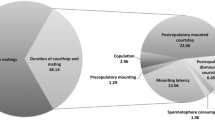Abstract
Reproductive behavior of the foam-nesting treefrog,Rhacophorus arboreus, is described. Oviposition was made either by an amplectant pair (a female, and an amplectant male) alone or by an amplectant pair and other males (joiners). The snout-vent length of males and females was negatively correlated with the date of the first appearance in the pond. The period of staying in the pond in males was longer than that in females. Physical body contacts of other males, and encounter calls by ampletant males were frequently observed before oviposition with joiners. Snout-vent length of the female and an amplectant male were positively correlated. Encounter calls by amplectant males were likely to precede movement of females. There was no difference of snout-vent length between amplectant males and joiners. Females moved the hindlimbs more frequently than males during oviposition. Amplectant males made encounter cells more frequently in oviposition with joiners, than oviposition without joiners. The patterns of transitions between acts of females and amplectant males were similar between oviposition with and without joiners. Females more frequently responded to amplectant males than joiners. Both the duration of a bout of the movements of hindlimbs of females and the interval between the bouts were longer in oviposition without joiners than that with joiners. The number of the movements per bout in oviposition without joiners was smaller than that with joiners. Encounter calls by amplectant males during oviposition tended to precede the hindlimb movements of females.
Similar content being viewed by others
References
Arak, A. (1983) Male-male competition and mate choice in anuran amphibians. pp. 181–210.In P. Bateson (ed.)Mate choice. Cambridge University Press, Cambridge.
Coe, M. J. (1967) Co-operation of three males in nest construction byChiromantis rufescens.Nature 214: 112–113.
Coe, M. J. (1974) Observations on the ecology and breeding biology of the genusChiromantis.Journal of Zoology, London 172: 13–34.
Emlen, S. T. (1968) A technique for marking anuran amphibians for behavioural studies.Herpetologica 24: 172–173.
Feng, A. S. and P. M. Narins, (1992) Unusual mating behavior of Malaysin treefrogs,Polypedates leucomystax.Naturwissenschaften 78: 362–365.
Fukuyama, K. (1991) Spawning behaviour and male mating tactics of a foam-nesting treefrog,Rhacophorus schlegelli.Animal Behaviour 42: 193–199.
Halliday, T. R. and P. A. Verrell (1984) Sperm competition in amphibians. pp. 487–508.In R. L. Smith (ed.)Sperm competition and the evolution of animal mating systems. Academic Press, Orlando, Florida.
Jennions, M. D., P. R. Y. Backwell and N. I. Passmore (1992) Breeding behaviour of the African frog,Chiromantis xerampelina: multiple spawning and polyandry.Animal Behaviour 44: 1091–1100.
Kasuya, E. (1992) Unusual mating, behavior of Malaysian treefrogs,Polypedates leucomystax.Naturwissenschaften 79: 138. [a comment on Feng and Narins (1992)]
Kasuya, E., H. Shigehara and M. Hirota (1987) Mating aggregation in the Japanese treefrog,Rhacophorus arboreus: a test of cooperation hypothesis.Zoological Science 4: 693–697.
Kasuya, E., T. Kumaki and T. Saito, (1992) Vocal repertoire of the Japanese treefrog,Rhacophorus arboreus.Zoological Science 9: 469–473.
Kato, K. (1956) Ecological notes on the green frogs during the breeding season. 2. breeding habit and others.Japanese Journal of Ecology 6: 57–61. (in Japanese with English summary)
Kusano, T., M. Toda and K. Fukuyama (1991) Testes size and breeding systems in Japanese anurans with special reference to large testes in the treefrog,Rhacophorus arboreus.Behavioral Ecology and Sociobiology 29: 27–32.
Martin, P. and P. Bateson (1986)Measuring behaviour Cambridge University Press, Cambridge.
Meddis, R. (1980) Unified analysis of variance by ranks.British Journal of Mathematical and Statistical Psychology 33: 84–98.
Meddis, R. (1984)Statistics using ranks. Basil Blackwell, Oxford.
Wells, K. R. (1977) The social behaviour of anuran amphibians.Animal Behaviour 25: 666–693.
Wilson, E. O. (1975)Sociobiology. The Belknap Press of Harvard University Press, Cambridge, Mass.
Author information
Authors and Affiliations
Corresponding author
Rights and permissions
About this article
Cite this article
Kasuya, E., Hirota, M. & Shigehara, H. Reproductive behavior of the Japanese treefrog,Rhacophorus arboreus (Anura: Rhacophoridae). Res Popul Ecol 38, 1–10 (1996). https://doi.org/10.1007/BF02514965
Received:
Accepted:
Issue Date:
DOI: https://doi.org/10.1007/BF02514965




